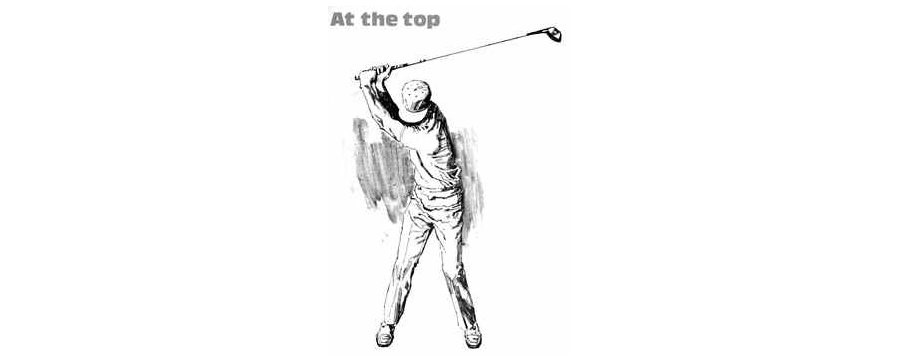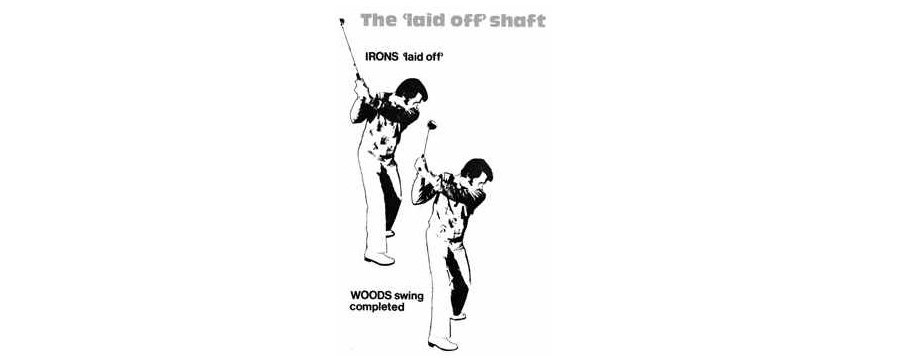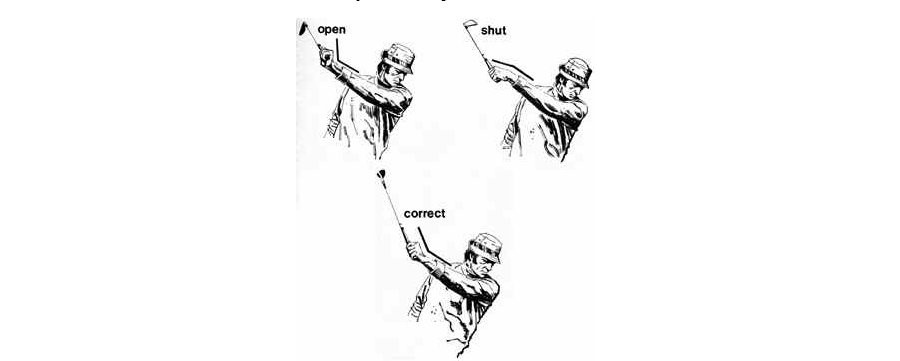Leslie King Tuition 8
We have said that the backswing is performed solely to place the club in a correct position at the top. Now let us define what is “a correct position at the top” means, and why it is important.
First, let’s recall that the shoulders are fully turned through 90 degrees, the left shoulder has not dropped as it came round to meet the chin, the right side of the body from the hip to shoulder has been cleared to the rear, the hips have tuned through 45 degrees, the right leg is still flexed and the left heel has risen slightly.

Leslie King Tuition 8
All of these factors have enabled us to reach the desired position at the top. The shaft of the driver should now be about horizontal to the ground, and parallel with the intended line of flight. I said, “about horizontal”. With the fairway woods and the irons the shaft will not have gone back quite as far. It will appear to be “laid off” as we say. This is simply due to the reduced wrist action with these shorter clubs, which is perfectly natural.
The point I want to stress is the shaft must be parallel to the intended line of flight or “laid off ” behind the hands as described above. The shaft (of any club) must on no account point across the intended line of flight. That is, to the right of the target. This “across line” position at the top leads to endless complications in the downswing as we shall see, and is in fact the result of an incorrect backswing.
Leslie King Tuition 8
It is also unnecessary for the shaft of the driver to dip below the horizontal. This is “overswinging”, and leads to loss of control in the downswing. The horizontal position is quite enough. Indeed, many top players don’t swing this far back, and are “laid off” at the top in the manner described.

Leslie King Tuition 8
What is meant by the “laid off” shaft and is it good technique?
Here is the completed backswing with a medium iron and a driver.
Note that the shaft of the driver is horizontal to the ground and parallel to the intended line of flight. The shaft of the iron however, has stopped well short of the horizontal and therefore appears to be “laid off” as we say. This is perfectly correct.
The shaft of the driver reaches a near horizontal position simply because of the additional wrist action that occurs naturally with the longer clubs. The shorter distance shots are naturally more “firm wristed”. That alone accounts for the different positions of the shaft.
It is important to realise that if the medium iron swing were to be completed the shaft would reach exactly the same position as the shaft of the driver and the blade angles of both clubs would be identical.
In short, both clubs are “on line” but one has gone back further than the other. Hence the laid off shaft with the irons is entirely correct.
Leslie King Tuition 8
One final point. Many golfers are under the impression that the swings with irons and woods are different…. or that there is less body turn with the medium irons. Both ideas are incorrect.
The basic swing action with all clubs is the same. The amount of body turn with all fairway clubs is also the same. The difference in the position of the shafts is accounted for solely by the additional natural wrist action employed when using the driver and the longer clubs.
Take care not to restrict your turn with the medium irons. If you do, you will not reach the correct position at the top.
The Sure Test of a Correct Backswing
Below, left, is the same correct position from another viewpoint. I want you to notice the “shape” of the player’s body. The line down his back to his hip forms a convex curve. The body curves slightly away from the target. This convex shape when the club is at the top of the backswing is common to all good golfers and is in fact the result of a correct series of movements in the backswing.
Contrast it with the concave body shape, below right. Here the player’s body curves towards the target. This posture is the result of the incorrect body movement in the backswing. this concave body shape when the club is at the top is perhaps the most common sight in golf, and is a sure sign of an incorrect action.
Check your body shape in a mirror. If it is convex you can be sure your turn is substantially correct. If it is concave, well, you have failed grasped what has gone before.

Leslie King Tuition 8
‘Across line’ at the top… across line at impact
Here is the concave swing shape again, with the left shoulder drop, the straight right leg and a right hip that has risen as it has gone back. This movement as we have seen puts the club shaft across the line at the top.
The club-head, club shaft and hands are all out of plane at the top. From here, only an outside loop (dotted line) down into the ball can result, leading to an impact across the line of flight. A swing down into the ball on the correct plane and line is virtually impossible without a major correction before the downswing begins.
It is an utterly hopeless position to be in at the top, and can be traced directly back to an incorrect takeaway, as we have seen.
Correct at the top… ‘on line’ for the downswing
The whole point about being “correct” at the top is that the club is now correctly positioned in the desired plane. When the left hand and arm reverses direction into the downswing, the club will simply swing down behind the hands while remaining in the same plane.
This will ensure a correct club line down into and along the intended line of flight.

Leslie King Tuition 8
The angle of the club-face at the top is critical
If the grip is correct and there is no wrist-rolling (or other errors) in the takeaway and backswing, a correct club-face (or blade angle) at the top of the swing can be achieved. Then, when the club is returned to the ball in the downswing it will be square, just as it was at address.
However, if wrist-rolling does take place during the takeaway and backswing the blade angle at the top is bound to be incorrect. It will be either ‘open’ or ‘shut’. Then the corresponding amount of wrist-roll will again be required in the downswing in order to ” square” up the blade at impact. this precision and delicate operation is obviously beyond the capacity of most players. Further it is an unnecessary complication that can be avoided.
In a sound swing action the correct blade angle at the top is automatically achieved, ensuring solid, square impact with the ball in the downswing. And this is what we want.
Below is the correct blade angle at the top with a driver and a short iron. Actually, the angles are identical. If the swing with the short iron were to progress further, placing the shaft at the same angle as the driver, the leading edges of both clubs would be perfectly aligned.

Leslie King Tuition 8

Leslie King Tuition 8
Key to correct blade angle at the top
The angle of the club-face (or blade) at the top is governed by the angle that the back of the left hand makes with the left forearm. At the top of the swing the left wrist should be slightly “cupped”
That is, the angle formed between the back of the left hand and the forearm should be about 30 degrees. This is ideal! This wrist position will place the club-face at the correct angle, namely (a) with the leading edge of the club vertical or (b) inclined at an angle of about 30 degrees to the vertical, or somewhere between these two. All other angles at the top are incorrect and will lead to inaccuracy and loss of power.

Leslie King Tuition 8
Open
Here, the angle between the back of the left hand and the forearm is much too pronounced.
The wrist is far too “cupped” and the club-face is consequently “open”. I call this a “concave position” of the left wrist. It is extremely common among handicap golfers and tends to promote a slice
Shut
Here is the opposite extreme, a “convex” position of the left wrist. Note how the hand is dropped below the line of the forearm, “shutting” the blade. This hand action is comparatively rare among handicappers, and tends to promote a “smoother” or a hook.
A word of warning – you may see some top players employing this wrist position at the top. Don’t be tempted to copy them! These “shut-faced” players combine the wrist position with a special type of body action in the downswing which enables them to return the club-face square at impact. Without this body action a monumental hook would result! Indeed, a hook is the constant enemy of all “shut-faced” players. Don’t flirt with this method!.
Correct
Here again is the correct left wrist position at the the top, and the correct blade angle that goes with it. A slightly “cupped” wrist and blade angle at about 30 degrees off the vertical. A correct grip, a square face at address, a free swing of the left hand and arm (without wrist roll) in the backswing, and a correct body turn combine to create this position.
A correct blade angle at the top coupled with a correct downswing movement will automatically produce a dead square impact of club with the ball, which is the secret of long, accurate shotmaking.
Next Lesson – Cause & Effect of Backswing Problems
